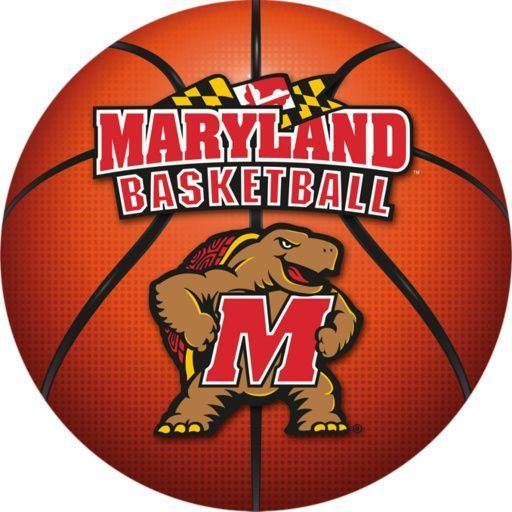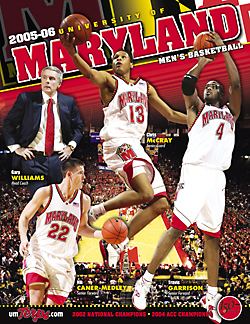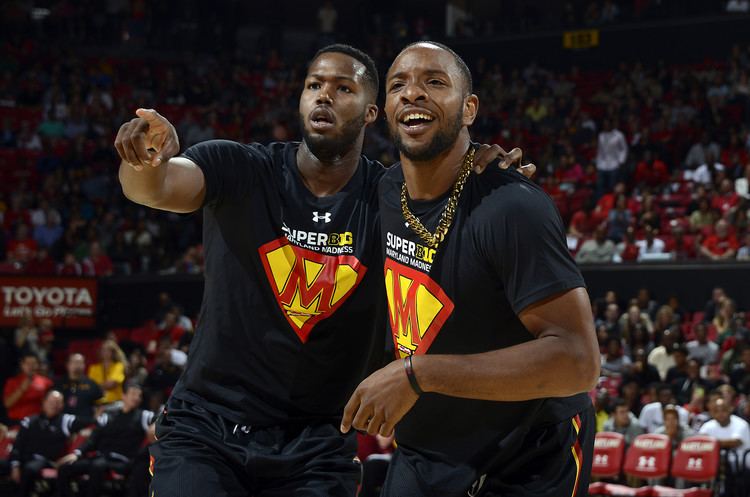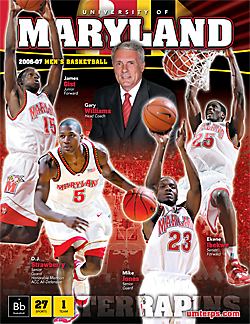Student section The Pride Away Alternate Mascot Testudo | Nickname Terps Home Away Colors Red, White, Black, Gold | |
 | ||
Arena/Stadium Xfinity Center College Park Profiles | ||
The Maryland Terrapins men's basketball team represents the University of Maryland in National Collegiate Athletic Association Division I competition. Maryland, a founding member of the Atlantic Coast Conference (ACC), left the ACC in 2014 to join the Big Ten Conference.
Contents
- Early years the H Burton Shipley era
- The Bud Millikan Era and the ACC
- Xfinity Center 2002Present
- Cole Field House 19552002
- Historical statistics
- Complete NCAA tournament results
- NIT results
- References
Gary Williams, who coached the Terrapins from 1989 to 2011, led the program to its greatest success, including two consecutive Final Fours, which culminated in the 2002 NCAA National Championship. Under Williams, Maryland appeared in eleven straight NCAA Tournaments from 1994 to 2004. He retired in May 2011 and was replaced by former Texas A&M coach Mark Turgeon.

The Terrapins played in what many consider to be the greatest Atlantic Coast Conference game in history — and one of the greatest college basketball games ever — the championship of the 1974 ACC Men's Basketball Tournament, in which they lost 103–100 in overtime to eventual national champion North Carolina State. The game was instrumental in forcing the expansion of the NCAA Men's Division I Basketball Championship, thus allowing for at-large bids and the inclusion of more than one team per conference. That Maryland team, with six future NBA draft picks, is considered by many to be the greatest team not to have participated in the NCAA tournament.

Early years – the H. Burton Shipley era

Before basketball became a permanent fixture in College Park, the school—then known as Maryland Agricultural College—met with little success in its intermittent attempts to establish a basketball team. Games were played sporadically during the 1904–1905, 1910–1911, 1913–1914, and the 1918–1919 seasons, going a combined 4–32. Basketball returned to stay for the 1923–24 season, when the school convinced former star quarterback H. Burton Shipley, who had been coaching at the University of Delaware, to come back to his alma mater. The Old Liners, as they were then known, joined the Southern Conference in their inaugural season. The team met with moderate success that year at 5–7 and also played its first games against future ACC rivals North Carolina and Virginia. The Old Liners had their first sustained success over the next four seasons, finishing at or above .500 in each of them and putting together an outstanding 24–9 record against Southern Conference foes. The Aggies also played their first games against what would become their two other biggest rivals in the future during that time, North Carolina State and Duke.

The school's biggest success during its formative years took place in the early 1930s, around the time it adopted its current nickname, Terrapins. After finishing second in the conference in 1930–31, Maryland won the Southern Conference tournaments, beating Louisiana State, North Carolina, Georgia, and Kentucky over five days, a feat they followed by winning the conference regular season crown the next year. The team also had its first individual star in Louis "Bosey" Berger who was named to All-America teams both seasons. It was during this stretch that the school erected a new home for its basketball teams, Ritchie Coliseum, which housed the team until Cole Field House replaced it a quarter of a century later.

Although the team would remain competitive throughout the rest of the decade, finishing as high as second in the conference regular season, it never again matched its achievements of the early part of the decade, and as the 1940s began, the school's basketball team fell on exceedingly hard times. Shipley tallied just one winning season in his last seven years before stepping down to focus on coaching the baseball team, a post he'd held for his entire tenure since returning to College Park. He was succeeded by Flucie Stewart. Following a pattern that has held to the present after a long-time coach has been replaced at the head of Maryland basketball, Stewart would not last very long, putting together three losing seasons in three tries during his brief time at Maryland.
The Bud Millikan Era and the ACC
The 1950s began with a new head coach leading the way, Bud Millikan. A disciple of legendary coach Henry Iba, Millikan's emphasis on defense and fundamentals would become hallmarks of the program over the next two decades. Maryland quickly reels off seven straight winning seasons under Millikan. For the 1953–54 season, the team had left its long-time home in the Southern Conference to join North Carolina, North Carolina State, Duke, Wake Forest, Virginia, Clemson, and South Carolina in the newly formed Atlantic Coast Conference. That season was perhaps the finest the Terrapins had experienced to date, finishing with a 23–7 record and a conference mark good enough for second in the league. Maryland experienced its first games as a ranked team, spending the final nine weeks of the season ranked in the AP Top 20, peaking at #11 before settling for a final ranking of #20. It also featured the school's first win over a ranked team when it beat local rival George Washington, then-number 7 in the country. The team was led by its second All-American, Gene Shue, who was honored in both that season and the prior year.
After that season, the team remained the only school outside of the North Carolina "Big Four" – Duke, UNC, North Carolina State, and Wake Forest – to consistently field competitive teams. In the ACC's second year, the Terps cracked the top ten for the first time, peaking at #6 in January before eventually finishing the season with a disappointing one-point loss to Virginia in the ACC Tournament quarterfinal round.
The Terps had another breakout season during the 1957–58 season. After a good regular season (17–6, 4th in the ACC), Maryland stunned the league by winning the ACC Tournament, including wins over #6 Duke and #13 North Carolina on back to back days to capture the title as well as the league's berth in the NCAA Tournament. The team routed Boston College 86–63 at Madison Square Garden with just two days of rest after the ACC Tournament, advancing to the East Regionals in Charlotte. The Terps lost a tight game to Temple in the round of 16 before beating Manhattan in the consolation game to secure third place in the East.
That would be the high-water mark for the Terps under Millikan. They experienced their first losing season under the coach the next season, although they did manage to finish third in the ACC, including its first ever win over a #1 ranked team when it beat North Carolina 69–51 in Cole Field House on February 21. By 1962–63, the bottom had dropped out and the Terps finished just 3–11 in the ACC, next to last in the standings. While Millikan managed to turn the program around in the mid-1960s, finishing in a second place tie in 1964–65 and above .500 overall again the next season, the feeling in College Park was that the game had passed the coach by, and he was replaced after the following season by assistant Frank Fellows. Fellows' tenure lasted just two seasons, both of which featured only eight wins.
Xfinity Center (2002–Present)
The Xfinity Center, which opened in the Fall of 2002, is the current home of the Maryland Terrapins men's and women's basketball programs. The building also features facilities for the wrestling and volleyball programs. The 17,950-seat state of the art on-campus facility is referred to as "The House that Gary Built" or "Comcastle," in reference to the arena's original name of Comcast Center, used from 2002 to July 2014. Xfinity Center provides one of the best home court advantages in the nation. This is largely due to the layout of the 4,000 seat student section which consists of the first ten rows surrounding the court in addition to the west wall of the arena, simply known as "the Wall", which was constructed at a 35-degree incline. Several former ACC opponents referred to the arena as the toughest place to play in the ACC.
Xfinity Center opened for Midnight Madness on October 11, 2002 and the first official men's game was a 64–49 victory over Miami University (Ohio) on November 24, 2002. On January 25, 2012, the court was renamed in honor of Gary Williams, the men's basketball coach who had retired the previous year.
The Xfinity Center welcomed 281,057 visitors over 16 games in its first season for an average of 17,566 which ranked 5th nationally in 2003. It was the first time Maryland had finished in the top 10
nationally in attendance since the 1976 season in which Maryland finished 4th with an average of 13,110 fans taking in games at Cole Field House. Every year from 2004–2010, Maryland finished between 4th and 9th nationally in attendance.
At the conclusion of the 2015–2016 season, Maryland is 205–42 (.830) all-time at Xfinity Center. Since 2003, Maryland has defeated 17 ranked opponents at Xfinity Center, including 11 top ten teams, eight top-5 teams, and a top-ranked team (Duke University in 2003).
Cole Field House (1955–2002)
Prior to 2002, the Terps spent 47 seasons—from 1955 to 2002—at Cole Field House. When college basketball was achieving its most explosive growth – from the late 1950s to the late 1970s – there was one college gymnasium on the East Coast that seated as many as 12,000 fans. Cole Field House epitomized the new big-time, main event status of college hoops, the sport of network TV and emerging legends. It was a building where history was routinely made, and fans could feel the echo of tradition and experience the electricity of top-flight college basketball. Additional seats were installed throughout the years to bring the final capacity to 14,596 (in 1993).
Cole Field House held its first East Regional finals in 1962, when NYU defeated St. John's in the final, 94–85. The Final Four was first held here in 1966 between Duke, Kentucky, Texas Western (now UTEP), and Utah. Texas Western (which started all black players) upset Kentucky's all-white team 72–65 in front of a crowd of 14,253. Future Maryland men's basketball coach Gary Williams, then a student, attended the game. Cole also hosted the Final Four in 1970 and is the nation's only on-campus arena to host multiple Final Fours.
Bud Millikan, the first Maryland coach at the venue, did not like its size saying at one point "It's like playing on a neutral court" with seats too far from the courts. In the late 1960s Lefty Driesell added a nearly 3,000 seats around the court raising the hometown decibel level. Upon adding additional seating to create a more intimate atmosphere with fans right along the court, Cole would develop into one of the best home court advantages in the country. Along with Notre Dame's Joyce Athletic Center, Cole is the site of the most upsets of top ranked opponents of any venue in college basketball. 7 No. 1 ranked teams have been upset inside Cole, with Maryland pulling the upset in 6 of those 7 games and the other being Texas Western's National Championship win over Kentucky in 1966.
Cole Field House was constructed in 1955 at a cost of 3.3 million. On December 2, 1955 Maryland played its first game at Cole beating rival Virginia 67–55. In 1972 the attendance record would be set as 15,287 fans packed into Cole and watched Maryland knock off North Carolina 79–77 in overtime. The final regular season game of the 2001 season at Cole saw Maryland defeat Virginia 102–67 for the most lopsided result in the rivalry's history. In 2002, in a game known amongst Maryland fans as the "Oh, He Steal" game, the 7th #1 ranked team would fall in Cole, as Maryland handed Duke an 87–73 defeat, taking over first place in the conference. Later that season Maryland would play its final game in Cole Field House, celebrating the regular season conference title with a 112–92 win over Virginia. Over 47 season, Maryland compiled an impressive 486–151 record at Cole Field House.
Historical statistics
*1988 tournament records vacated by NCAA due to use of ineligible player
Complete NCAA tournament results
The Terrapins have appeared in the NCAA Tournament 26 times. Their combined record is 41–25. They were National Champions in 2002.
* 1988 tournament records vacated by NCAA due to use of ineligible player
Seed History
The NCAA began seeding the tournament with the 1979 edition.
NIT results
The Terrapins have appeared in the National Invitation Tournament (NIT) eight times. Their combined record is 14–7. They were NIT champions in 1972.
